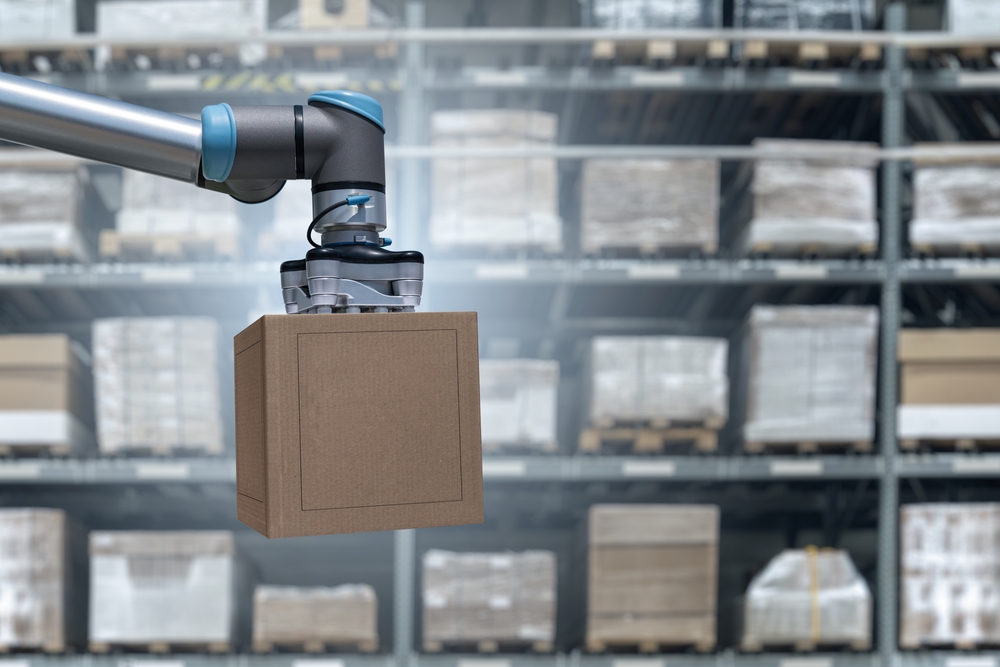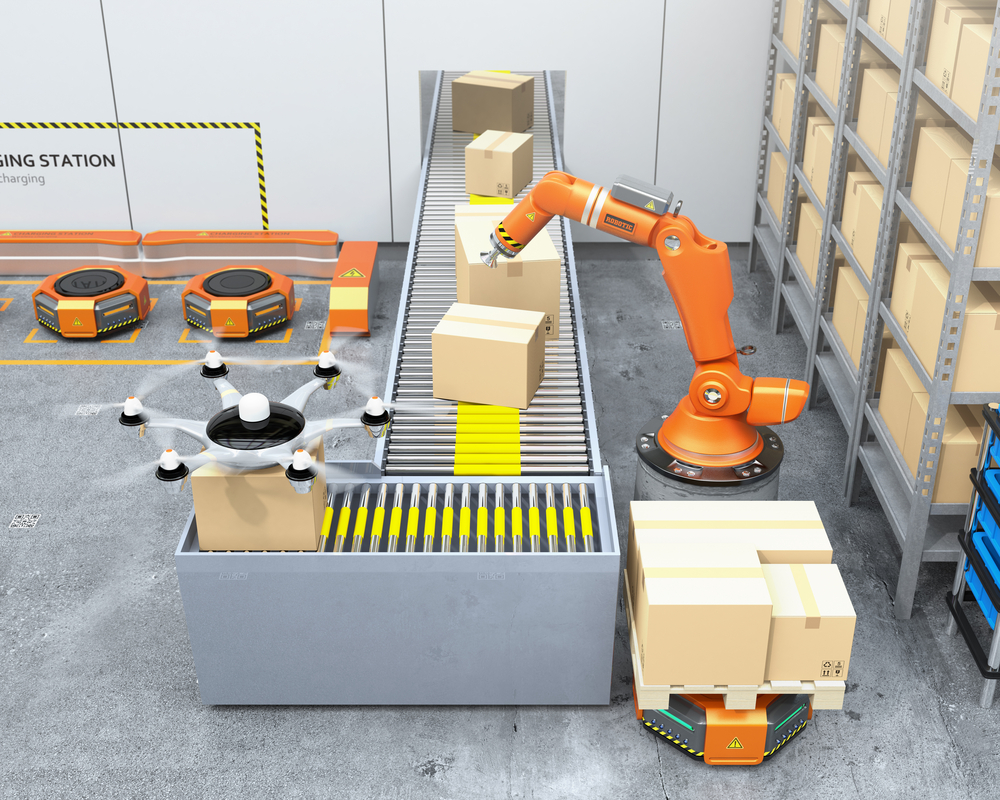Palletizing has long been a common practice in the packaging industry, but with the continuous advancement of technology, new and innovative solutions are constantly emerging. This essential guide to robotic palletizing comprehensively discusses the underlying technology, its potential to improve your packaging process, and the compelling reasons why you should integrate this system into your business.
By automating and optimizing the process of creating, filling, and stacking pallets with goods, robotic palletizing systems have become a reliable and efficient alternative to conventional palletizing methods. With the use of robotic palletizers, businesses can reduce labor and operating costs, increase productivity and occupational safety, minimize downtime, and deliver high-quality output, all while staying ahead in the Industry 4.0 transformation. The guide also features the TM Palletizing Operator, a comprehensive, application-based solution exclusively designed for palletizing automation that includes built-in guiding software, collision tests, and palletizing simulations. By exploring Techman Robot’s AI cobots, equipped with advanced AI and machine learning capabilities, businesses can unlock the full potential of Industry 4.0 and realize their automation goals.
What Is A Robotic Palletizer (Robot Palletizer)?
Robotic palletizers are sophisticated machines that use a computerized system to handle materials in a factory or warehouse environment. Typically situated between a pallet dispenser and a pallet conveyor belt line that carries incoming goods, robotic palletizers automate and optimize the process of creating, filling, and stacking pallets with goods. The process involves a robot or motor that lifts and stacks a corrugated piece of cardboard, metal, or plastic from the production line and moves them to its designated pallets. By streamlining this process, businesses can achieve higher levels of efficiency, productivity, and safety, while also reducing labor and operating costs. Moreover, with the integration of AI cobots, such as those offered by Techman Robot, businesses can unlock the full potential of Industry 4.0 and take their automation goals to the next level.
V2A043 TM AI Cobot – SSD Factory – Palletizing
Common Applications of Collaborative Robots
Automated workstations make for a versatile process that can be used in a variety of manufacturing applications. Here are some of the most common applications of a robotic arm :
- Picking and placing items on a pallet: Cobot palletizers can be programmed to pick up and place items on a pallet, making it easier and faster to stack items.
- Soldering or welding materials together: Robotic arm can also be used to solder or weld materials together, reducing the need for human labor in the process.
- Quality testing and inspecting products: Automated cobots can be equipped with sensors and cameras to inspect and test products, ensuring that only high-quality items make it onto the pallet.
- Machine tending: Cobots can also be used to tend to other machines, such as loading and unloading materials from a conveyor belt.
- Gluing and sealing products: Robots can also be used to apply glue or sealant to products, ensuring that they are securely packaged before being stacked on a pallet.
- Polishing or sanding material: Automated cobot applications can be used to polish or sand palletized material, such as wood or metal, to increase its quality and appearance.
By automating these processes with a robotic arm, businesses can not only increase their efficiency and productivity but also improve the quality and consistency of their output.
Why Palletizing with A Collaborative Robot (Cobot)?
Incorporating robotic palletizing using a collaborative robot (cobot) into your operations offers a multitude of advantages, including enhanced accuracy, improved efficiency, significant cost savings, and increased employee safety. These benefits are derived from the cobot’s advanced programming, which allows it to work faster and more efficiently than traditional methods. Cobots are designed to work safely alongside humans and can be programmed to perform various tasks, reducing the need for additional training and supervision. They are also less prone to errors, further reducing the chances of accidents or workplace injuries. In addition, cobots help minimize downtime by quickly and accurately completing tasks, while also providing constant quality output that is more consistent and accurate than conventional palletizing methods.
-
Saves on Labor and Operating Costs
In a fast-paced factory environment, a robotic palletizing system can provide exceptional speed and efficiency when compared to traditional methods. By incorporating collaborative robots (cobots) into the process, a business can reduce the number of workers required to operate the machines and the time needed to complete a job. Moreover, cobots eliminate the risk of human error, reducing the need for additional training and supervision. Their advanced programming allows them to work faster and more efficiently than traditional methods, providing a constant output of higher accuracy and precision. Cobots are designed to work safely alongside humans and can be programmed to perform various tasks, reducing the need for additional training and supervision.
They are also less prone to errors, further reducing the chances of accidents or workplace injuries. By minimizing downtime, utilizing full capacity, and delivering constant quality output, cobots can help businesses achieve their deadlines on time and eliminate the need for employee overtime and overtime pay. Overall, incorporating robotic palletizing with cobots into your operations can offer significant advantages, including enhanced accuracy, improved efficiency, significant cost savings, and increased employee safety.
-
Increases Labor Productivity and Occupational Safety
Collaborative robots (cobots) are engineered to operate safely alongside human personnel and can be programmed to perform various tasks with ease. Due to their lack of physical limitations, cobots can execute tasks much more rapidly and accurately than human workers, thereby reducing the time required to complete specific parts of the process and increasing overall productivity rates within the workplace. Furthermore, as previously mentioned, cobots are less susceptible to committing errors, which in turn decreases the likelihood of accidents or workplace injuries occurring.
-
Minimizes Downtime and Utilizes the Full Capacity
Through the automation of the palletizing process, collaborative robots (cobots) are able to significantly reduce downtime by efficiently and accurately completing tasks without requiring extensive supervision or maintenance. This enables businesses to fully utilize their operational capacity, meet deadlines, and eliminate the need for employee overtime and overtime pay.
-
Delivers Constant Quality Output
Collaborative robots (cobots) are programmed with precision and accuracy in mind, delivering consistent high-quality output that surpasses conventional palletizers. By utilizing cobots, the likelihood of errors occurring is significantly reduced, and they can swiftly adapt to varying production demands.
-
Assists in Industry 4.0 Transformation
Robotics technology has a critical role in the Fourth Industrial Revolution, commonly referred to as Industry 4.0. Smart technology, enabled by robotics, is leveraged across multiple industries, including warehousing, food processing, logistics management, and manufacturing, to help businesses achieve the objectives of Industry 4.0. Real-time data collection, facilitated by robotic palletizing, provides valuable insights to optimize processes and improve productivity.
Palletizer System That Works Best with Your Automation Tasks
Introducing the TM Palletizing Operator – an all-in-one solution exclusively designed for palletizing automation. This comprehensive, application-based solution is an ideal choice for those who want to design their own hardware layout. The system includes built-in guiding software that assists users in setting up their specific palletizing tasks and processes. With the TM Palletizing Operator Kit, you can customize your own layout, making it ideal for any automation situation, as not all off-the-shelf solutions for automatic palletizing are compatible with every single factory spacing layout out there.
This efficient palletizer system can be used across multiple industries, including warehousing, logistics, food processing, and manufacturing. With the integration of the TM Palletizing Operator, businesses can carry out palletizing simulations and collision tests before the actual operations, reducing the likelihood of any unexpected issues or errors and ensuring that production is done accurately and safely. The duration of pallet programming is shortened, from the typical 6 months to only 5 minutes, with the built-in guiding software that helps users properly set up their specific palletizing tasks and processes.
V2A034 TM Robot – TM AI Cobot Palletizer
Techman Robot’s AI cobots are equipped with advanced AI and machine learning capabilities, making them an ideal choice for a wide range of applications, including material handling, AOI inspection, and palletizing. Their built-in smart vision system provides ease of use and versatility, and these cobots are capable of improving their efficiency over time. Businesses can leverage these cobots to unlock the full potential of Industry 4.0, a revolution that is transforming various industries, including warehousing, food processing, logistics management, and manufacturing. Real-time data collection, facilitated by robotic palletizing, provides valuable insights to optimize processes and improve productivity. Take a look at Techman Robot’s AI cobots now, and explore the full possibilities that Industry 4.0 can offer.


